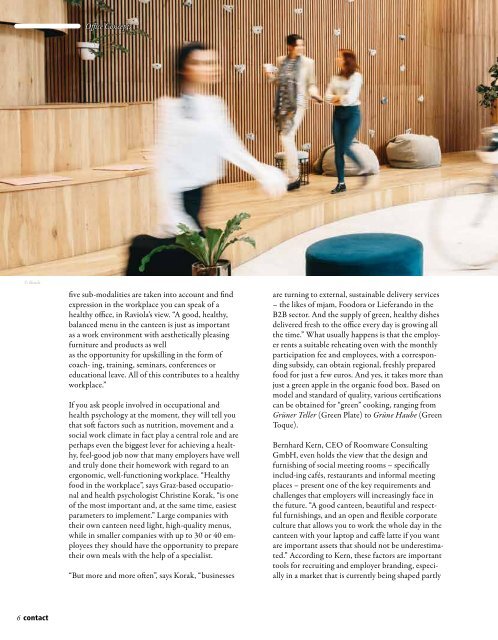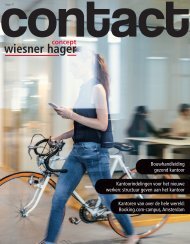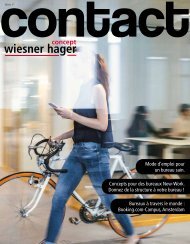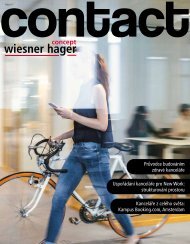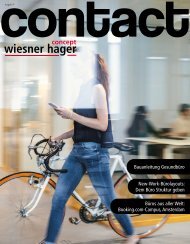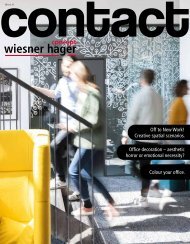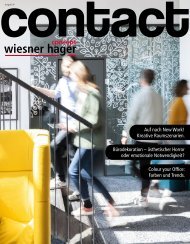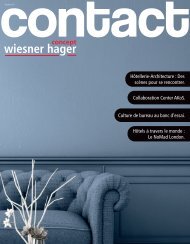contact_magazine_#37_EN
Is sitting the new smoking? “A day in the office without moving is the same on a health basis as smoking a pack of cigarettes!” – US physician and oncologist David B. Agus is being deliberately provocative with this statement, of course, in an effort to focus attention on the important topic of prevention. Our guest author, Wojciech Czaja, has expanded on this, addressing healthy nutrition too, in the cover story. The result is a guide to building a healthy office.
Is sitting the new smoking?
“A day in the office without moving is the same on a health basis as smoking a pack of cigarettes!” – US physician and oncologist David B. Agus is being deliberately provocative with this statement, of course, in an effort to focus attention on the important topic of prevention. Our guest author, Wojciech Czaja, has expanded on this, addressing healthy nutrition too, in the cover story. The result is a guide to building a healthy office.
You also want an ePaper? Increase the reach of your titles
YUMPU automatically turns print PDFs into web optimized ePapers that Google loves.
Office Concepts<br />
© iStock<br />
five sub-modalities are taken into account and find<br />
expression in the workplace you can speak of a<br />
healthy office, in Raviola’s view. “A good, healthy,<br />
balanced menu in the canteen is just as important<br />
as a work environment with aesthetically pleasing<br />
furniture and products as well<br />
as the opportunity for upskilling in the form of<br />
coach- ing, training, seminars, conferences or<br />
educational leave. All of this contributes to a healthy<br />
workplace.”<br />
If you ask people involved in occupational and<br />
health psychology at the moment, they will tell you<br />
that soft factors such as nutrition, movement and a<br />
social work climate in fact play a central role and are<br />
perhaps even the biggest lever for achieving a healthy,<br />
feel-good job now that many employers have well<br />
and truly done their homework with regard to an<br />
ergonomic, well-functioning workplace. “Healthy<br />
food in the workplace”, says Graz-based occupational<br />
and health psychologist Christine Korak, “is one<br />
of the most important and, at the same time, easiest<br />
parameters to implement.” Large companies with<br />
their own canteen need light, high-quality menus,<br />
while in smaller companies with up to 30 or 40 employees<br />
they should have the opportunity to prepare<br />
their own meals with the help of a specialist.<br />
“But more and more often”, says Korak, “businesses<br />
are turning to external, sustainable delivery services<br />
– the likes of mjam, Foodora or Lieferando in the<br />
B2B sector. And the supply of green, healthy dishes<br />
delivered fresh to the office every day is growing all<br />
the time.” What usually happens is that the employer<br />
rents a suitable reheating oven with the monthly<br />
participation fee and employees, with a corresponding<br />
subsidy, can obtain regional, freshly prepared<br />
food for just a few euros. And yes, it takes more than<br />
just a green apple in the organic food box. Based on<br />
model and standard of quality, various certifications<br />
can be obtained for “green” cooking, ranging from<br />
Grüner Teller (Green Plate) to Grüne Haube (Green<br />
Toque).<br />
Bernhard Kern, CEO of Roomware Consulting<br />
GmbH, even holds the view that the design and<br />
furnishing of social meeting rooms – specifically<br />
includ-ing cafés, restaurants and informal meeting<br />
places – present one of the key requirements and<br />
challenges that employers will increasingly face in<br />
the future. “A good canteen, beautiful and respectful<br />
furnishings, and an open and flexible corporate<br />
culture that allows you to work the whole day in the<br />
canteen with your laptop and caffè latte if you want<br />
are important assets that should not be underestimated.”<br />
According to Kern, these factors are important<br />
tools for recruiting and employer branding, especially<br />
in a market that is currently being shaped partly<br />
by employees due to the shortage of labour.<br />
Salzburg-based occupational psychologist Christian<br />
Blind, who focuses on evaluating mental stress in<br />
the workplace, also advises companies to pay more<br />
attention than ever before to the work-life balance.<br />
“With the coronavirus pandemic, much of<br />
what we had constructed up to that point disappeared<br />
in one go. The meteoric rise of home-based<br />
work, new digital communication tools and<br />
extremely dynamic developments in recent years<br />
mean that we now have a lot to learn and establish<br />
again.” This is not only an investment in efficiency,<br />
productivity, fewer sick days and both subjective<br />
and objective wellbeing in the workplace, but also<br />
a necessary measure under the Austrian Employee<br />
Protection Act (ArbeitnehmerInnenschutzgesetz,<br />
ASchG), according to which it has been mandatory<br />
to conduct a regular physical and psychological<br />
evaluation of the workplace since 2013. “The only<br />
problem is that not all companies are aware of this”,<br />
says Blind.<br />
As good as the average office has now become, as<br />
much as the focus is naturally on ergonomic furnishings,<br />
on good acoustics, on appealing lighting,<br />
on ecological building materials and on the proven<br />
health-promot-ing greening of indoor and outdoor<br />
spaces, which has now become part of planning<br />
practice – almost all experts see a clear need to catch<br />
up in one area, namely the indoor climate. The range<br />
of experiences in the industry includes too cold, too<br />
warm, too dry, too draughty and too intolerable.<br />
Even in many new buildings, the unanimous observation<br />
is that there are repeatedly climatic problems.<br />
“The indoor climate is probably the only parameter<br />
that does not come with an average value, on which<br />
basis it is also therefore not possible to make a<br />
generally valid, generally representative statement”,<br />
says Sonia Raviola. “That’s because temperature is<br />
perceived differently by every-one – partly due to<br />
physical condition and partly due to aspects of gender.<br />
The fact is that women and men fundamentally<br />
feel temperature differently for fat burning reasons.”<br />
The subjective perceived delta lies between two and<br />
five degrees Celsius.<br />
So, what can we do? “Talk about it openly and<br />
respectfully, and deal with the issue constructively”,<br />
recommends Raviola. “Just as we have succeeded in<br />
meeting the demands of a healthy office in so many<br />
respects already, I am confident that this point too<br />
can still be solved – not with a universal solution,<br />
but with a catalogue of individual adjusting screws.”<br />
Wojciech Czaja<br />
6 <strong>contact</strong><br />
<strong>contact</strong> 7


